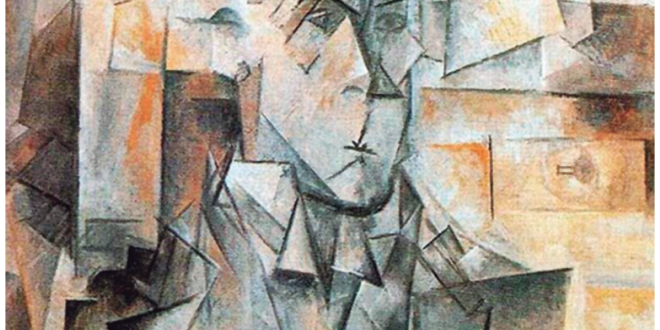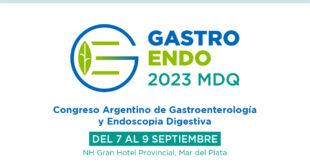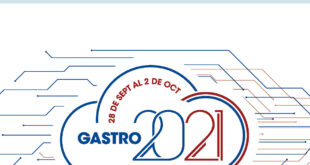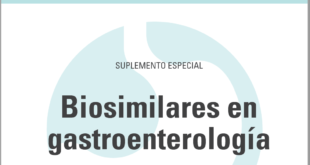
Coordinador: Carlos Guido Musso
Doctor en Medicina por la Universidad de Salamanca, España.
Departamento de Ciencias Humanas. Instituto Universitario del Hospital Italiano de Buenos Aires, Argentina.
Acta Gastroenterol Latinoam 2021;Sup Esp:4-5
Recibido: 01/02/2021 / Aceptado: 05/05/2021 / Publicado online en www.actagastro.org el 26/07/2021
Introducción
En esta oportunidad analizaremos la pintura El retrato de Wilhelm Uhde de Pablo Picasso (1853-1890), siguiendo así con la serie dedicada al concepto de evolución personal.
«Que vuestro hablar sea Sí, sí, No, no».
(Mateo 5, 37)
Descripción de la obra
En esta pintura, Pablo Picasso muestra al crítico de arte Wilhelm Uhde mediante diversas perspectivas caleidoscópicas, con un estilo propio del cubismo hermético.1 Picasso representa en esta obra las múltiples facetas en que se desgrana la ilusoria personalidad única que toda persona cree tener, cuando en realidad suele estar sujeta a la influencia de múltiples yoes, cada uno de los cuales se manifiesta en distintas oportunidades.1, 2
Análisis de la obra
Como enuncia el principio de correspondencia de la sabiduría perenne, en cada ser humano está presente la humanidad entera, de modo que en todo sujeto están presentes, de forma manifiesta o no, todas las personalidades. De esta manera cada sujeto está conformado por un haz de yoes, cada uno de los cuales va tomando el comando de su “personalidad” (máscara) en distintas circunstancias. Resulta entonces que en este nivel elemental del ser, un yo distinto toma el comando del sujeto en distintos momentos (falsa personalidad), tornando al ser humano en una máquina a merced de sus diversos yoes, sobre todo de aquellos de influencia negativa: yoes egoístas, mentirosos, envidiosos, etc. La evolución en el nivel del ser solo comienza cuando el ser humano empieza a observar este fenómeno no solo en el prójimo, sino fundamentalmente en sí mismo (no solo ve la paja en el ojo ajeno, sino sobre todo la viga en el propio), y a continuación comienza a desatender la influencia de sus yoes destructivos, para identificarse con sus yoes positivos, y reunirlos en un único yo (“yo esencial” o verdadera personalidad) que consigue alinear el pensar, el decir y el actuar, obteniendo así coherencia interna y externa. Este proceso evolutivo, que desde ya es difícil (muchos serán llamados, mas pocos serán los elegidos), presenta avances y retrocesos, pero su concreción es el camino que permite pasar del sujeto mecánico fragmentado y sufriente (oscuridad) al individuo cabal, autónomo y sereno (luz).3, 4
Concluimos que la obra El retrato de Wilhelm Uhde de Pablo Picasso constituye una gran oportunidad para comprender el fenómeno de la multiplicidad de yoes al que suele estar sometido el ser humano.
Aviso de derechos de autor © 2021 Acta Gastroenterológica Latinoamericana. Este es un artículo de acceso abierto publicado bajo los términos de la Licencia Creative Commons Attribution (CC BY-NC-SA 4.0), la cual permite el uso, la distribución y la reproducción de forma no comercial, siempre que se cite al autor y la fuente original.
© 2021 Acta Gastroenterológica Latinoamericana. Este es un artículo de acceso abierto publicado bajo los términos de la Licencia Creative Commons Attribution (CC BY-NC-SA 4.0), la cual permite el uso, la distribución y la reproducción de forma no comercial, siempre que se cite al autor y la fuente original.
Cite este artículo como: Musso CG. Arte y evolución personal: El retrato de Wilhelm Uhde de Pablo Picasso. Acta Gastroenterol Latinoam. 2021;Sup Esp:4-5.
Referencias
- Picasso. En Ricart J (Ed). Grandes maestros de la pintura. Barcelona. Editorial Sol 90. 2007.
- Musso CG. Obras maestras del arte universal y la medicina: El retrato de Ambroise Vollard por Pablo Picasso (1881-1973). Evidencia. 2010:59.
- Nicoll M. Psychological commentaries on the teaching of Gurdjieff and Ouspensky. Vincent Stuart Publishers. London.1941.
- Dalai Lama, Goleman D. Destructive emotions. How can we overcome them? New York. Bantam Books. 2003.
Acta Gastroenterol Latinoam – Suplemento Especial 2021
Art and Personal Evolution: The Portrait of Wilhelm Uhde by Pablo Picasso

Coordinator: Carlos Guido Musso
Doctor of Medicine. University of Salamanca, Spain.
Department of Human Science. Instituto Universitario del Hospital Italiano de Buenos Aires, Argentina.
Acta Gastroenterol Latinoam 2021;Sup Esp:6-7
Received: 01/02/2021 / Accepted: 05/05/2021 / Published online in www.actagastro.org on 26/07/2021
Introduction
In this opportunity we will analyze the painting The portrait of Wilhelm Uhde by Pablo Picasso (1853-1890), continuing with the series dedicated to the concept of personal evolution.
«Let your speech be Yes, yes, No, no».
(Matthew 5, 37)
Artwork Description
In this painting, Pablo Picasso shows the art critic Wilhelm Uhde represented by diverse and kaleidoscopic perspectives, applying a characteristic style of hermetic cubism.1 Picasso through this artwork represents the multiple aspects in which the illusory unique personality that every subject thinks he/she possesses is revealed, when in reality it is usually subject to the influence of multiple “ME’s”, each one of those manifest in different opportunities.1, 2
Artwork Analysis
As the perennial wisdom correspondence principle states: on each human being is present the entire humanity, so that all personalities are present in every subject, manifestly or not. In this way each subject is confirmed by a bundle of ME’s, each one of those slowly takes control of its “personality” (mask) in different circumstances. As a result, on this elemental level of the being, a different I takes command of the subject in different moments (false personality), turning the human being into a machine at the mercy of its diverse ME’s, mainly of those of negative influence: selfish ME’s, liars, envious, etc. The evolution on the level of being only initiates when the human being begins to observe this phenomenon not only on the neighbor, but fundamentally on itself (he/she does not just see the straw in someone else’s eye but mainly the beam in his/her own eye), and then he/she begins to disregard the influence of his/her destructive ME’s, to identify him/herself with his/her positive ME’s, and reunite them into a single me (essential me or real personality) which gets to line up his/her thought, speech and action, obtaining internal and external coherence. This evolutionary process, which of course is difficult, (lots will be called, but litle ones will be chosen) presents advances and retreats, but its concretion is the way which let’s go from the mechanical, fragmented and suffering subject (darkness) to the thorough, autonomous and serene individual (light).3, 4
We conclude that the artwork “The Portrait of Wilhelm Uhde” by Pablo Picasso constitutes a great opportunity to comprehend the phenomenon of the multiplicity of ME’s, to which the human being is usually submitted to.
Copyright © 2021 Acta Gastroenterológica latinoamericana. This is an open-access article released under the terms of the Creative Commons Attribution (CC BY-NC-SA 4.0) license, which allows non-commercial use, distribution, and reproduction provided the original author and source are acknowledged.
© 2021 Acta Gastroenterológica latinoamericana. This is an open-access article released under the terms of the Creative Commons Attribution (CC BY-NC-SA 4.0) license, which allows non-commercial use, distribution, and reproduction provided the original author and source are acknowledged.
Cite this article as: Musso CG. Art and Personal Evolution: The Portrait of Wilhelm Uhde by Pablo Picasso. Acta Gastroenterol Latinoam. 2021;Sup Esp:6-7.
References
- Picasso. En Ricart J (Ed). Grandes maestros de la pintura. Barcelona. Editorial Sol 90. 2007.
- Musso CG. Obras maestras del arte universal y la medicina: El retrato de Ambroise Vollard por Pablo Picasso (1881-1973). Evidencia. 2010:59.
- Nicoll M. Psychological commentaries on the teaching of Gurdjieff and Ouspensky. Vincent Stuart Publishers. London.1941.
- Dalai Lama, Goleman D. Destructive emotions. How can we overcome them? New York. Bantam Books. 2003.
Acta Gastroenterol Latinoam – Special Supplement 2021
 Revista ACTA Órgano Oficial de SAGE
Revista ACTA Órgano Oficial de SAGE






